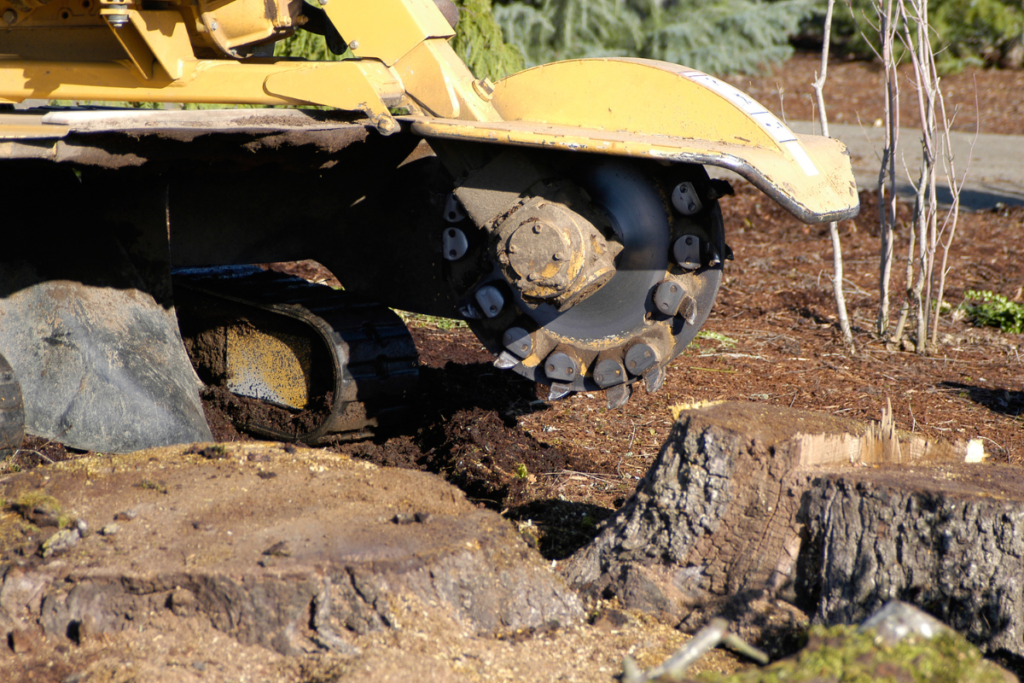When you decide to remove a tree from your property, whether due to safety concerns, aesthetics, or practicality, it’s natural to focus on the immediate task of cutting down the tree itself. However, what often gets overlooked is the stump left behind. Stumps, the remnants of tree trunks left firmly rooted in the ground after tree removal, can pose several challenges and considerations for homeowners. They not only affect the landscape’s appearance but also present potential safety hazards and can hinder future landscaping plans. Let’s explore in more detail whether stump removal is necessary and why it might be beneficial.
Understanding the Stump
A tree stump is more than just a piece of wood sticking out of the ground; it represents the remaining base of the tree after its main trunk has been cut down. Stumps vary widely in size depending on the tree species, the method of tree removal used, and how much of the trunk was cut down. Some stumps are low to the ground, barely noticeable among the grass, while others can be several feet tall, prominently interrupting the landscape with their presence. Understanding the size and characteristics of the stump left behind is crucial in determining the best course of action for its removal.

Benefits Of Stump Removal
Stump removal offers numerous benefits, including enhanced safety by eliminating tripping hazards, improved aesthetics with a cleaner landscape, and prevention of pest infestations. It also frees up space for new landscaping projects, reduces the risk of new tree growth, and supports environmental health by preventing decay-related issues and promoting healthier soil conditions.
- Enhanced Aesthetic Appeal: Removing stumps improves the overall appearance of your property by eliminating unsightly remnants of tree removal. This enhances curb appeal and allows for more flexible landscaping and outdoor design options.
- Improved Safety: Stump removal eliminates tripping hazards, making your yard safer for children, pets, and visitors. It also reduces the risk of damage to lawn equipment caused by accidentally hitting stumps while mowing.
- Prevention of Pest Infestations: Decaying stumps attract insects like termites, ants, and beetles, which can spread to nearby plants or even invade your home. Removing stumps eliminates potential habitats for pests, reducing the need for pesticide treatments.
- Space Optimization: By removing stumps, you free up valuable space in your yard that can be used for planting new trees, creating garden beds, installing outdoor furniture, or expanding your living area.
- Environmental Benefits: Stump removal can benefit the environment by reducing the release of carbon dioxide and other greenhouse gases associated with decaying stumps. It also helps prevent the spread of diseases and pests to other plants, promoting overall ecosystem health.
Methods of Stump Removal: From Grinding to Complete Extraction
Choosing the right method for stump removal depends on various factors, including the size of the stump, its location, and your budget:
- Stump Grinding: This method involves using a stump grinder, a specialized machine that grinds the stump and roots into small wood chips. These chips can then be used as mulch or disposed of. Stump grinding is effective for most stumps and is relatively quick compared to other methods.
- Chemical Removal: Chemical stump removers are another option, designed to accelerate the natural decomposition process. This method involves drilling holes into the stump and applying a chemical solution that breaks down the wood over time. It’s a cost-effective option but requires patience as it can take several months to see results.
- Complete Extraction: For homeowners looking to completely remove all traces of the stump and its roots, complete extraction is the best option. This typically involves digging out the stump and its extensive root system, ensuring that no remnants are left behind. While more labor-intensive and costly, complete extraction provides a clean slate for future landscaping projects.
Safety Considerations: The Hidden Dangers of Tree Stumps
Tree stumps, though seemingly innocuous, can pose significant safety hazards within your property. Often obscured by grass or foliage, stumps create tripping hazards that can lead to injuries, particularly among children and elderly individuals. The risk of tripping and falling increases during activities like lawn mowing or playing, where stumps are not immediately visible. Moreover, stumps can cause damage to lawn equipment if accidentally hit, leading to costly repairs or replacements. By removing tree stumps promptly after tree removal, you mitigate these risks and create a safer environment for everyone on your property.Furthermore, decaying stumps can attract pests such as termites, ants, and beetles, which may eventually find their way into your home. These pests not only pose a threat to other plants in your garden but can also compromise the structural integrity of nearby buildings. Removing stumps eliminates this potential habitat for pests, reducing the likelihood of infestations and preserving the health of your landscape.
Aesthetic Consequences: How Stumps Affect Your Property’s Appearance
The presence of tree stumps can detract significantly from the aesthetic appeal of your property. A well-maintained landscape can be marred by the sight of a stump, disrupting the overall harmony and visual flow. Stumps can make it difficult to mow around and create obstacles for landscaping projects such as planting new trees or creating garden beds. Additionally, stumps can take years to decompose naturally, during which time they remain an unsightly focal point in your yard.
Moreover, stumps may hinder efforts to enhance your outdoor living space, limiting options for seating areas or recreational activities. By opting for stump removal, you not only improve the appearance of your property but also regain the freedom to design and utilize your outdoor space to its fullest potential. Whether you prioritize curb appeal or enjoy spending time outdoors, removing stumps can transform your landscape into a more inviting and aesthetically pleasing environment.
Environmental Concerns: The Role of Stumps in Ecosystem Health
Tree stumps play a complex role in ecosystem health, influencing soil composition, moisture retention, and the diversity of plant and animal species. While leaving stumps to decompose naturally can contribute organic matter to the soil, it may also attract fungi and bacteria that accelerate decay processes. However, decaying stumps can also release carbon dioxide and other greenhouse gases into the atmosphere, impacting local air quality and contributing to climate change.
Furthermore, stumps left untreated can harbor diseases and pests that may spread to nearby plants, affecting overall ecosystem balance. In sensitive ecosystems or areas with endangered species, the removal of invasive species or diseased trees may be necessary to preserve biodiversity. Balancing environmental conservation with property maintenance often requires careful consideration of local regulations and consultation with arborists or environmental specialists.
Conclusion
The decision to remove a tree often raises the question of what to do with the stump left behind. While it may seem like a minor detail, addressing stump removal offers significant benefits beyond simply improving your property’s appearance. By opting for stump removal, you enhance safety by eliminating tripping hazards and prevent potential pest infestations that could affect both your landscape and home. Moreover, it allows you to maximize the use of your outdoor space, whether for gardening, recreational activities, or simply enjoying a more open and inviting environment.
Ready to reclaim your yard and enhance its safety and beauty? Contact Tree Service Legends today at (352) 558-2348. Our experienced team in Ocala is dedicated to providing professional stump removal services that meet your needs and exceed your expectations. Let us help you transform your landscape into a safer, more aesthetically pleasing space.
